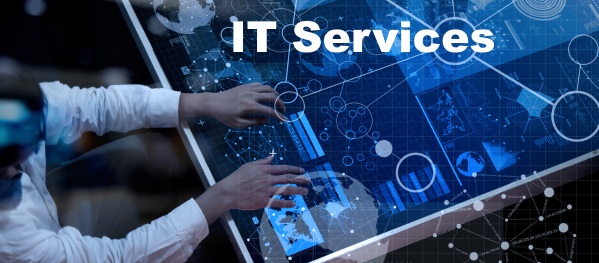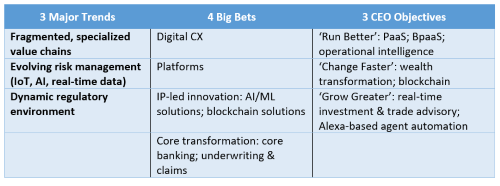Search posts by keywords:
Filter posts by author:
Related NEAT Reports
Other blog posts
posted on Jun 01, 2018 by Rachael Stormonth

Readers of the NelsonHall Quarterly Updates on Tech Mahindra over the last two years will be aware of initiatives that have taken place to turn around the LCC business it acquired, and also of recent investments such as a minority stake in Altiostar. This blog looks at some of the other sectors in which Tech Mahindra operates, and at some broad developments around service delivery.
Two recurring themes in the presentations at Tech Mahindra’s recent global analyst event in Hyderabad were ‘Future’ (a refreshing change from ‘Digital’) and ‘3-4-3’ – indicating the overarching intent to demonstrate how Tech Mahindra is developing its offerings portfolio to be relevant to clients in each of its target markets. Also evident was a strong focus on upskilling of personnel and innovating service delivery. Tech Mahindra is well known for its heritage as a specialist IT and engineering R&D services provider in the communications vertical, for engineering services in the auto and aerospace sectors, also for its work in supporting other Mahindra Group companies. To what extent is the company able to leverage these capabilities today to support other types of enterprises in their digital initiatives?
3-4-3 approach informing vertical initiatives
In his keynote, CEO CP Gurnani introduced the ‘3-4-3’ theme informing the portfolio strategy. For each target vertical, the company has picked 3 major trends, which have informed the selection of 4 focus areas in portfolio development (the ‘big bets’), and also the sector positioning in helping clients address 3 core CEO objectives: 'Run Better, Change Faster, Grow Greater'.
To briefly illustrate the application of the ‘3-4-3’ approach to two sectors: Communications, its largest and most mature (while Tech Mahindra’s dependence on this sector group has been reducing, it still represents nearly 43% of revenues) and BFSI, one of its smallest vertical units (13% of revenues).
Communications industry

BFSI sectors

Articulating what 3-4-3 means at sector level appears to be a work-in-progress (the links across the 3 dimensions are not always clear), but it is a neat approach for clarifying investment priorities and for developing a narrative around business outcomes for each target vertical: ‘Run, Change, and Grow’ workshops are likely to have been an important instrument in the very evident recent improvement in client mining (see recent NelsonHall Quarterly Update for details).
Tech Mahindra would be expected to have a strong narrative around the future of the Communications sector, so how does the 3-4-3 strategy translate into its investment priorities in the financial services sectors? Well, the acquisitions since 2015 of:
- BIO Agency brought in capabilities around digital CX (~£12.5m rev)
- Target Group (~£51m rev) brought in a platform BPaaS capability for processing lending and investment products. Target subsequently acquired the mortgage processing platform of Commercial First
- Sofgen in 2015 brought in Temenos and Avaloq core banking capabilities, focusing on German-speaking Switzerland.
BIO and Target Group both operate in the U.K. However, we have not seen cross-fertilization between them to develop more of a transformational story. Tech Mahindra continues to target relevant smaller scale opportunities in the mid-sized banking sector in the U.K. and EMEA.
Manufacturing industry
Let’s look at another broad vertical, one where Tech Mahindra has been enjoying double digit growth recently: Manufacturing. Here, it is benefiting from:
- Existing domain experience around connective devices, its strong heritage in product engineering services, also from supporting other Mahindra Group divisions, and from this, a close understanding of how AI and IoT technologies can be applied to enable new digital business models
- Some recent investments, such as its ‘Factory of the Future’ Lab in Hyderabad, which focuses on the use of technologies such as IoT, cloud, analytics, robotics, and AI in the manufacturing sector
- Its acquisition of Italian automotive product design house Pininfarina
- Partnerships, such as with Toshiba Digital Solutions.
In short, in discrete manufacturing, Tech Mahindra is well positioned for newer types of IT services around IT/IoT convergence and is investing in developing a range of new offerings. We might possibly see further tuck-in acquisitions, perhaps to help it better leverage Pininfarina for offerings around connected device.
More likely, we think, are additional digital agency tuck-in acquisitions, perhaps folding these into the BIO umbrella, with the U.S. the most obvious geography, to scale its digital agency capabilities and align these more closely to Tech Mahindra’s principal target sectors.
‘New Age Delivery’ for software of the future
As well as the vertical stories, we also got a brief introduction to this initiative to transform how software development is done, essentially to increase the speed (and quality) of code production. Tech Mahindra’s ‘New Age Delivery’ platform (it might be branded differently, but for this blog I’ll refer to it as NAD) combines various approaches and tools the company has been developing in the last few years. Key attributes and related assets (both proprietary IP and third-party) include:
- Automation and AI across the SDLC, leveraging its AQT (Automation, Quality, Time) suite of automation and AI tools, including TACTIx (IT and network ops), FixStream Meridian (IT ops) LitmusT (testing), Entelio (chatbots) and UNO (RPA), and Acumos, an open source platform for building and sharing AI applications
- Enabling the adoption of Agile and DevOps at scale, leveraging the ADOPT framework that it launched back in 2014, based on the CollabNet TeamForge ALM platform. Includes an Agile training kit
- Reusability, leveraging its ‘Blue Marble’ cloud-based business service integration platform for microservices
- Collaboration, using the Xtra Mile crowdsourcing platform
- Upskilling/reskilling capabilities including through gamification
- Co-creation with clients.
Some of these assets have been used by Tech Mahindra for some years; others such as Acumos, launched a few months ago, are much newer. Acumos, co-developed with AT&T and hosted by The Linux Foundation, is a marketplace where users can access AI and ML models packaged into microservices and connect them to data sources to build new AI applications. Self-organized peer groups, e.g. within a company, can share, test and review AI solutions. The initial target sectors (unsurprisingly given it is an AT&T and Tech Mahindra collaboration) are Telecoms, Media & Technology: use cases suggested include development of AI applications for use in video analytics, content curation and AR/VR. Acumos thus supports the key principles of reusability and co-creation noted above. Development of AI models will primarily be on open source; this is a timely move.
Tech Mahindra’s NAD platform also includes ‘Design Thinking as a Service’ (DTaS), 'Capability as a Service' (CaaS) and 'Upskilling as a Service’ (UaaS) which includes online training (takes in a developer’s rankings from the crowdsourcing platform).
The platform is helping Tech Mahindra position as a services aggregator, managing projects in which onboarded ‘capability partners’ can bid for pockets of work (code packages) in projects. The next stage of the initiative appears to be onboarding partners with the requisite skillsets (e.g. mobile) into the platform.
As well as extending Tech Mahindra’s reach in areas where there are skills shortages, the UaaS elements are of critical importance in re- and up-skilling its internal talent for newer technologies and methods of working (it includes a predictive tool for identifying appropriate candidates).
The NAD platform thus aims to address a number of critical success factors in software delivery today. It is clearly particularly useful for complex digital transformation projects. Presumably, Tech Mahinda can also extend its use to managed services engagements.
Tech Mahindra is currently using the platform with four clients in the telecoms and retail sectors.
All tier 1 IT services providers are busily accelerating their use of automation and AI in service delivery, with the focus still primarily in infrastructure operations. Tech Mahindra’s approach with its NAD platform (which focuses on software development) has a broader vision, one that includes harnessing crowdsourcing in a systematic manner, bringing in specialist partners, UaaS, and the Acumos marketplace, all of which are likely to be very attractive to clients.
The NAD initiative will be a key asset in evolving its delivery capability to help it achieve its target of having 50% of revenue from digital services by 2020.
TechMNxt: positioning statement and ecosystem program
‘TechMNxt’ is a term being used by Tech Mahindra as a positioning statement, as it works on becoming a ‘next gen’ IT services company in terms of technologies, business model, and employee capabilities. The company is also using TechMNxt to refer to a global program to engage with tech start-ups, alliance partners and academia to develop offerings in the areas of AI, ML, cybersecurity, next-gen networks, big data, IoT, etc., and also to open CoEs. A recent example of an initiative under this banner is opening a Maker’s Lab in a BT Research Campus in the U.K. Expect to see the brand being used increasingly.
Apart from its acquisition of HCI, the company does not appear to be planning to significantly increase its onshore presence in the U.S. to reduce its (relatively high) dependence on H-1B visas and also improve client proximity for (early stage) digital projects. Its strategy appears to continue to focus on the kind of activity that can be offshored.
Summary
CP Gurnani has been vociferous for some years about the need for the Indian IT industry to reinvent itself and to be capable of innovation, and this ambition is very clear at Tech Mahindra. The company’s heritage and domain expertise in Communications and its strong capabilities in engineering services will continue to be an important facet of its specialization. In addition, in separate conversations with the company, NelsonHall has been impressed by how Tech Mahindra is applying AI in its engineering services business.
The NAD platform is also a well thought-through stitching together of a number of approaches to software development.
While Tech Mahindra is convincing in how it is developing its offerings for the Communications and selected discrete manufacturing sectors, there is more work to be done in developing a coherent narrative about its ability in some of its other target sectors to support companies in major digital transformation initiatives. The fact that it still refers to its non-Communications units as its ‘Enterprise’ business is telling. We note that although BIO Agency and Pininfarina (both acquired in 2016) got star billing, there was no mention at all of HCI, its large recent acquisition in the U.S. healthcare sector.
A final note… unlike some Indian-oriented service providers (by which I mean those firms with primarily Indian leadership as well as Indian delivery capabilities, not just those headquartered in India), Tech Mahindra remains very proud of its Indian culture and centricity. Most of the client examples provided over the two days were Indian organizations (though 47% of its revenues are from U.S. headquartered organizations), which gave a slightly local feel to this global analyst event.
